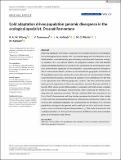Files in this item
Cold adaptation drives population genomic divergence in the ecological specialist, Drosophila montana
Item metadata
| dc.contributor.author | Wiberg, Ralf Axel Wilhelm | |
| dc.contributor.author | Tyukmaeva, Venera | |
| dc.contributor.author | Hoikkala, Anneli | |
| dc.contributor.author | Ritchie, Michael Gordon | |
| dc.contributor.author | Kankare, Maaria | |
| dc.date.accessioned | 2021-06-14T09:30:06Z | |
| dc.date.available | 2021-06-14T09:30:06Z | |
| dc.date.issued | 2021-07-30 | |
| dc.identifier | 274437304 | |
| dc.identifier | 02fca2d5-d54d-477f-aace-f7d1c2f81c5c | |
| dc.identifier | 85107783111 | |
| dc.identifier | 000661035700001 | |
| dc.identifier.citation | Wiberg , R A W , Tyukmaeva , V , Hoikkala , A , Ritchie , M G & Kankare , M 2021 , ' Cold adaptation drives population genomic divergence in the ecological specialist, Drosophila montana ' , Molecular Ecology , vol. 30 , no. 15 , pp. 3783-3796 . https://doi.org/10.1111/mec.16003 | en |
| dc.identifier.issn | 0962-1083 | |
| dc.identifier.other | ORCID: /0000-0001-7913-8675/work/95772415 | |
| dc.identifier.uri | https://hdl.handle.net/10023/23350 | |
| dc.description | Funding: UK Natural Environment Research Council (Grant Number(s): NE/L501852/1, NE/P000592/1); Academy of Finland (GrantNumber(s): 267244, 268214, 322980), Ella ja Georg Ehrnroothin Säätiö. | en |
| dc.description.abstract | Detecting signatures of ecological adaptation in comparative genomics is challenging, but analysing population samples with characterised geographic distributions, such as clinal variation, can help identify genes showing covariation with important ecological variation. Here, we analysed patterns of geographic variation in the cold-adapted species Drosophila montana across phenotypes, genotypes and environmental conditions and tested for signatures of cold adaptation in population genomic divergence. We first derived the climatic variables associated with the geographic distribution of 24 populations across two continents to trace the scale of environmental variation experienced by the species, and measured variation in the cold tolerance of the flies of six populations from different geographic contexts. We then performed pooled whole genome sequencing of these six populations, and used Bayesian methods to identify SNPs where genetic differentiation is associated with both climatic variables and the population phenotypic measurements, while controlling for effects of demography and population structure. The top candidate SNPs were enriched on the X and fourth chromosomes, and they also lay near genes implicated in other studies of cold tolerance and population divergence in this species and its close relatives. We conclude that ecological adaptation has contributed to the divergence of D. montana populations throughout the genome and in particular on the X and fourth chromosomes, which also showed highest interpopulation FST. This study demonstrates that ecological selection can drive genomic divergence at different scales, from candidate genes to chromosome-wide effects. | |
| dc.format.extent | 14 | |
| dc.format.extent | 1006463 | |
| dc.language.iso | eng | |
| dc.relation.ispartof | Molecular Ecology | en |
| dc.subject | Chill coma recovery time | en |
| dc.subject | Cline populations | en |
| dc.subject | Cold tolerance | en |
| dc.subject | CTmin | en |
| dc.subject | D. montana | en |
| dc.subject | Environmental adaptation | en |
| dc.subject | Genomic divergence | en |
| dc.subject | GE Environmental Sciences | en |
| dc.subject | QH301 Biology | en |
| dc.subject | QH426 Genetics | en |
| dc.subject | DAS | en |
| dc.subject.lcc | GE | en |
| dc.subject.lcc | QH301 | en |
| dc.subject.lcc | QH426 | en |
| dc.title | Cold adaptation drives population genomic divergence in the ecological specialist, Drosophila montana | en |
| dc.type | Journal article | en |
| dc.contributor.sponsor | NERC | en |
| dc.contributor.institution | University of St Andrews. Centre for Biological Diversity | en |
| dc.contributor.institution | University of St Andrews. Institute of Behavioural and Neural Sciences | en |
| dc.contributor.institution | University of St Andrews. School of Biology | en |
| dc.contributor.institution | University of St Andrews. St Andrews Bioinformatics Unit | en |
| dc.identifier.doi | 10.1111/mec.16003 | |
| dc.description.status | Peer reviewed | en |
| dc.identifier.grantnumber | NE/P000592/1 | en |
This item appears in the following Collection(s)
Items in the St Andrews Research Repository are protected by copyright, with all rights reserved, unless otherwise indicated.

